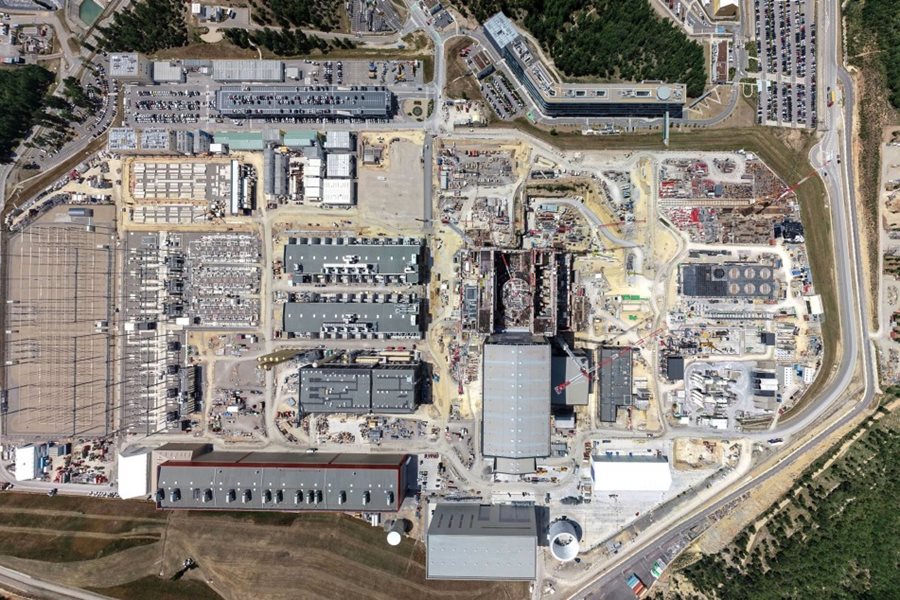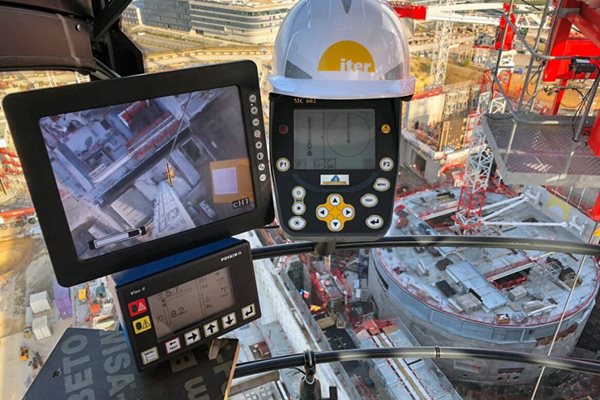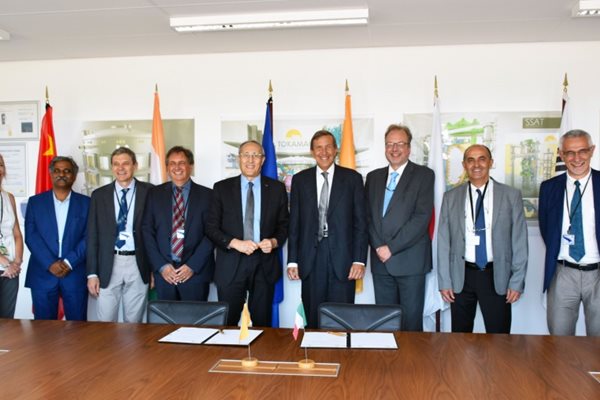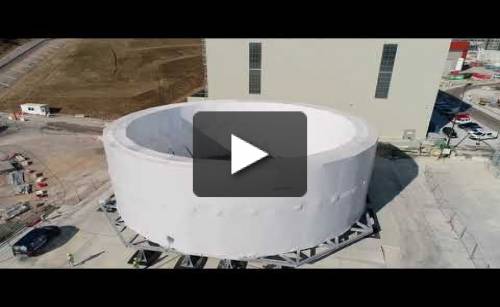
you're currently reading the news digest published from 23 Jul 2019 to 29 Jul 2019
featured3
video1
press18
featured
Assembly | A colossal task made manageable
For the execution of work during the next project phase—machine and plant assembly up to First Plasma—the ITER Organization has chosen a contractual approach that emphasizes manageably sized work packages with strong risk management. Nine major assembly and installation contracts are foreseen. Starting in March 2020 with the first major lift operation—the delivery of the cryostat base to the Tokamak Pit—and ending with the closure of the cryostat lid, the first phase of ITER assembly covers the construction of the core machine and the installation of plant systems needed for First Plasma. While the ITER Organization is responsible for the surveillance of all construction activities and final compliance with requirements, including nuclear safety requirements in France, the work will be carried out by contractors selected for their industrial know-how, experience, resources, skills and proven track record. 'The relationship between the oversight body—the ITER Organization, and its Construction Management-as-Agent MOMENTUM—and the executors (contractors) is of primordial importance,' says Christophe Dorschner, of the Procurement & Contracts Division. 'All together, we will be carrying out what is probably the most difficult sequences of assembly and installation works ever attempted in a first-of-a-kind construction project, and we need to do so in full respect of safety, specification, schedule and cost.' The ITER Tokamak is a one-of-a-kind machine, with 15 major sub-systems and as many as 300 very heavy, very large components. The size and weight of the major components, the precise assembly tolerances, the specialized tooling required, the diversity of manufacturers, the tight schedule, the multiple contractors ... all combine to make ITER an engineering and logistics challenge of enormous proportions. 'As a first-of-a-kind device, there are areas for which no prior industrial knowledge exists,' says Katsumi Okayama, acting head of the Construction Department. 'The ITER Organization will be providing input to inform the works in these cases based on R&D, trials and studies.' In developing its strategy for the assembly of the ITER machine and plant, the ITER Organization began by looking carefully at other large construction projects and benchmarking best practices. This groundwork led to the development of a number of core principles for the tendering and contract phases: Strive for cost and schedule control and flexibility through manageable lots; Minimize interference and interfaces between the different contractual scopes; Secure timely work execution by foreseeing temporary backup; Benefit from industry knowledge and know-how wherever possible; Allow industry to propose methods or processes within well-defined boundaries to accelerate or optimize work. For the purpose of tendering, assembly and installation work on the ITER construction platform has been organized in three zones (see the colour coding in the diagram below)—the Tokamak Complex (except the machine); the Tokamak machine (Tokamak Pit, Assembly Hall and Cleaning Building); and the balance of plant (all plant and auxiliary buildings). Each zone is as physically isolated as possible, with its own access paths and laydown locations in order to minimize interference. Within these zones, work will be executed under nine major assembly and installation contracts. 'We have chosen to divide the assembly scope into manageable work packages with time phasing and clear responsibility for performance in order to permit better schedule and cost control throughout the lifetime of the contracts,' says Katsumi. 'This approach will give us the flexibility we need to work with uncertainty—either in the effective handover dates of certain work zones, the availability of tooling, or the risk that some components may be delayed or require adjustment on arrival.' Time phasing means that work will be carried out based on construction work packages that are released by the ITER Organization in achievable—and trackable—batches. In some cases, contractors will be involved in the engineering development of the work packages to provide early input on construction optimization and methodology. For the most complex and time-sensitive areas—the Tokamak machine and the Tokamak Complex—the choice has been made to preserve peer competition by splitting the works in these areas between at least two contractors. It also protects the ITER Organization in the case of contract default, as one contractor can take over in a relatively short amount of time from the other. Contracts are awarded through competitive call for tender. First, the ITER Organization invites companies from the ITER Members to express interest through the 'Call for Nomination' process. This stage is followed by a pre-selection of candidate tenderers (the 'Pre-Qualification Application'), and finally the tender invitation is effectively issued ('Call for Tender'). (See more about the ITER procurement process here.) The global tendering phase for the assembly and installation contracts is now drawing to a close. All Balance of Plant contracts have been issued; the two Tokamak Assembly (TAC) contracts have been awarded (but not yet signed); and the two Tokamak Complex (TCC) tenders are under evaluation. The ITER Newsline will have a full report on contract awards in September.
Crane operator | A cabin in the sky
There are times, at dusk, when the ITER construction platform resembles an airport, with roads and buildings illuminated by yellow and white lights. From their cabins 50 to 80 metres overhead, the crane operators are almost like pilots, with a privileged viewpoint over the entire scene. 'In a construction project, crane operators are in a category of their own,' says Philippe Pinlou Cervantes, who operates a crane on the ITER worksite for the French company GTM Sud. 'We sit in our cabin up in the sky, and perform challenging operations that require full time concentration and perfect coordination with the other workers—both on the ground and in other cranes. The only contact we have with the solid ground is the banksman, the person who helps us with our manoeuvring. It is not unlike the relationship between a pilot and an air traffic controller, or an astronaut and mission control ...' Five giant cranes are positioned around the Tokamak Complex construction site, soaring from 50 to 85 meters overhead. From cabins at the top of each one, operators manipulate levers and foot pedals to lift, move, position and reposition loads such as scaffolding, formwork, steel rebar, or cherry picker cranes—all of the heavy materials and tools needed for the construction work in and around the Tokamak Complex. Reaching the 'office' every day is no easy job. Philippe operates crane #2 (C2), which is 85 metres in height. To access his cabin, he has to climb up a long, thin ladder or take a lift to facilitate his 'commute.' Once there, the rules are strict. In most cases—especially the taller cranes—the operator stays in his cabin during the entire shift. Radio is the only means of communication he has with the banksman, combined with a camera, a screen and a joystick. The banksman is fully dressed in orange—the only one on site with this colour—in order to increase his visibility and to facilitate visual contact with the operator in his cabin who is watching his screen closely. The banksman guides the crane operators, helps them complete their works and gives up-to-date information about what might be going on all around. 'Traffic is heavy, just like at an airport, and the five cranes must coordinate and wait for the banksman's green light and instructions before getting started on any operation. He acts as our eyes on the ground and his help is very precious in carrying out our mission successfully and avoiding any danger.' Like pilots, crane operators have the privilege of enjoying breathtaking and ever-changing panoramas. Before working at ITER, Philippe operated a crane at several important building projects in Marseille, including skyscrapers where his cabin was 170 metres above the ground. The variety of his assignments feeds another one of his passions: amateur photography. He regularly shares the photos he captures from his unique perspective over worksites and cities with friends on social media. 'One day I will produce my own photobook to share my unique experiences with the world. I will be proud to say that I have contributed to building the box that will contain a future star on Earth!'
Neutral Beam Test Facility | A new agreement for a new era
The ITER Organization and the Italian consortium Consorzio RFX* have signed a new agreement governing the construction and operation of the ITER Neutral Beam Test Facility. Ratified in a small ceremony on 25 July, the agreement takes effect in January 2020. Two separate bilateral arrangements—one between Consorzio RFX and the European Domestic Agency Fusion for Energy, and the other between Fusion for Energy and the ITER Organization—currently govern the construction and progressive commissioning and operation of the Neutral Beam Test Facility in Padua, Italy, which has been underway since 2012. All parties involved viewed the complex governing structure as a hindrance to efficient execution of decisions, and had expressed interest in finding a better way forward. 'The Neutral Beam Test Facility has progressed well,' says Deirdre Boilson, Head of the Heating & Current Drive Division at ITER. 'But that was largely due to the dedication and motivation of the people involved, working around the difficulties inherent in a three-way agreement. Under the current agreements, the work was headed by a program committee, which was non-executive. Under the new agreement, this structure is replaced by a steering committee made up of senior executives from each partner, and chaired by the ITER Organization Director-General.' The purpose of the test facility is to serve as a test bed to demonstrate the design concepts underpinning the ITER heating neutral beams and to provide essential input to the design of the components procured for ITER. All results will be transferred to the design packages of the Procurement Arrangements covering the neutral beam system by 2027 to allow the neutral beam systems to be in operation at ITER by 2032. After this initial stage, the Neutral Beam Test Facility program in Padua will enter into a second stage, in which it will serve as a test bed for on-going performance enhancement. The new agreement between Consorzio RFX and the ITER Organization is expected to expedite work during both stages by establishing a direct contractual relationship between the two parties concerned—who are also the main stakeholders—and by establishing clear executive control and a clear set of governing procedures. One example already underway is the approval of annual work programs. Under the terms of the new agreement, the executive-run steering committee appoints a project manager and an advisory committee, which is made up of experts selected from around the world. The project manager is responsible for developing and executing a work program for each year. Well before the beginning of the year, the project manager sends the work program to the advisory committee, who review the work program, and associated costs, and advise the steering committee on whether or not to approve the work program. In the spirit of speed and efficiency, the preparation for the start of the new agreement has already commenced immediately following ratification of the new agreement. During the preparatory meeting, three key processes were agreed: appointing the project manager, nominating the advisory committee, and preparing for the 2020 work program ... all to take effect as of January 2020. Click here to download the Consorzio RFX press release (in Italian). * Consorzio RFX is a research organization supported and promoted by CNR (Consiglio Nazionale delle Ricerche), ENEA (Agenzia Nazionale per le Nuove Tecnologie, l'Energia e lo Sviluppo Economico Sostenibile), Università di Padova, INFN (Istituto Nazionale di Fisica Nucleare) and Acciaierie Venete S.p.A.



